On the
Wayside for piano
and string quartet
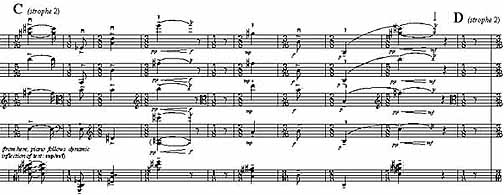
(fragment from On the Wayside: score order: violins, viola,
'cello and piano (L.H.))
| listen to
on the
wayside (REQUIRES QuickTime) |
"Fold into Fold": Symmetry and Parallelism
in Music and Poetry
Structure in both music and poetry is temporal, that is, it unfolds in both
space
and time as a kind of journey the listener makes through new,
unknown terrain.
This structure as it is experienced or perceived depends on an interweaving
of
but two thing: similarity and difference. With similarity,
whether of sound or
movement or meaning, we have a kind of generalized rhyme. That is, like the
words in sequence, time/dime/mime effortlessly fold or 'melt' into one another,
similarities tend to attract each other and merge. On the other hand, contrasts
or differences, like oil and water, tend to by varying degrees repel one
another,
creating separation.
Based on similarity, parallelism in poetry is a well-known effect. It is
usually
thought of as a kind of repetition of a similar patterns of movement. For
example,
we might have a phrase which is repeated with slight but significant variations:
On the way to school, echoed by,
On the way to church, followed by,
On the way to jail, etc.
Notice that rhyme is not necessary. The key feature is rather that the sounds
or words
change, whereas the underlying rhythmic pattern remains constant.
With the musical composition presented here, On the Wayside, this
kind of
parallelism takes place on many temporal levels at the same time, but most
importantly
in the way the large-scale structure cycles through similar rhythmic patterns
over and
over again. Of course, this happens all the time in popular music. There,
one verse after
the other is frequently added as the same melodic pattern remains essentially
the same. In
On the Wayside, however, this principle is turned on its head: the
rhythmic pattern
generated by the text remains constant while the sonic content—the melody
as it were, is re-
invented with each new turn of a cycle. This makes it possible for the music
to gradually
transform itself, moving from amorphous long, sustained tones to the highly
articulate,
rhythmic chanting of the four voices of the string quartet to virtuosic unison
leaps of
the entire ensemble. All the while, the same spoken text—and
imagery—underlies
the whole.
The Poem, On the Wayside
for Owenuma Blue Sky
What's a weed but the
unwanted noise of another
man's music. But beyond
the margin, that little strip of
uncultivated life to the
side of a
well-travelled road, rank
growth is my splendor.
Everything needs a
place to be, and here, even the
weeds feel at
home, a free space where the trouble-
some have gathered together, un-
folding their own songs,
f l o w e r i n g
in peace.
'Stepping' the Poem into Music
With this version of On the Wayside for string quartet (or small orchestra
(6; 6; 5; 4; 0))
and piano, instead of the poem being 'set to music,' the rhythm of the spoken
text literally
generates the movement of the piece. That is why, with but one exception,
the meter shifts
with every bar, each measure articulating a beat or accent in the poem. (This
is in principle
just like tapping with one hand the rhythm of the beats or accents of the
text you are reading
at the present moment, the only difference being that the movement displayed
in the score
has, for better or worse, been "captured" or "written down" in musical notation.)
At
first, given the quick tempo, this might seem unnecessarily difficult or
even impossible for
an ensemble to play. But with time, especially if care is taken always to
begin with the
actual sound of the poem—reciting it inwardly as one plays—it will
begin to appear that
the music—its articulations and gestures—is almost speaking.
The sound of the strings
together with the piano amplifies this effect, creating what I like to think
of as a 'talking'
ShimmerClavier.
In a way, this constitutes a significant departure from how music in the
Western tradition has
approached poetry generally. Normally, one begins with some preconceived
abstract metrical
pattern, like a 4/4 or 5/4 bar, and then makes the text more or less 'fit
the mold,' so to speak.
In the past, much of the energy of Modernism was directed toward getting
rid of these overly
rigid patterns. Like Ezra Pound, himself a notable musician, once said, "
To break
the pentameter, that was the first heave." Here then, we have the
modest beginnings of a new
musical-poetic form. Building upon the ground-breaking work of the early
20th century
and doing away with overly-simplified rhetorical notions of 'feet' and
'x-ameters" altogether,
the intention is to create a quality of movement which is both free and yet
at the same time highly
disciplined and ordered. As the poem itself has it, what we need is "a
free space where the
troublesome have gathered together, unfolding their own songs, flowering
in peace."
Here is an example, taken from the beginning of the poem, of moving from
patterns of
beats and steps (syllables) in the poem to specific musically
notated rhythms:


And here is the rhythmic pattern of an entire stanza: (If you would
like to see the
entire poem notated for voice in this way, go to
On the Wayside:
Voice .)
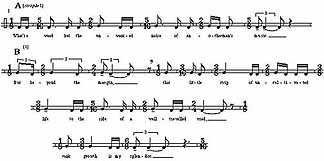
The following fragment shows how the rhythm of the poem creates a complex
unison
sound in the strings:
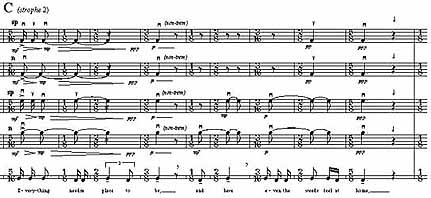
Musical scores, even for those with a great deal of experience, can be difficult
to read. It is
frequently easier to get s sense of the whole movement of piece with a simple
sketch. Below:
a diagram of how the texture of the composition changes from beginning to
end:
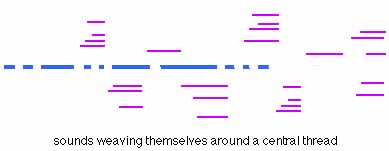
And lastly, an example of the very quickly changing textures of the
ShimmerClavier,
taken from the middle of the piece:
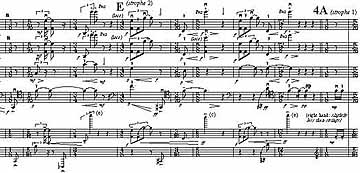
| back to
Picture/Poems: Central Display
| go to the full score of
On the
Wayside |
| On the Wayside:
Piano Score |
On the Wayside:
Poem Cycle |
| The Circle in the
Square: Central Display |
About
Cliff Crego |
| Other websites by Cliff Crego:
picture-poems.com |
The Poetry of Rainer Maria
Rilke | Dutch Poetry:
*r2c* |
Created and maintained in Northwest Ohio,
USA.
(II.24.2000)
Questions regarding performance
materials to
score-info@cs-music.com;
Copyright © 1999-2002 Cliff Crego All Rights
Reserved






